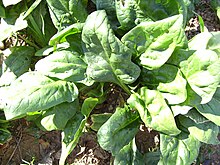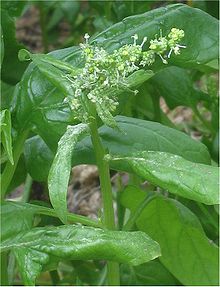Spinach (Spinacia oleracea) is an edible flowering plant in the family of Amaranthaceae. It is native to central and southwestern Asia. It is an annual plant (rarely biennial), which grows to a height of up to 30 cm. Spinach may survive over winter in temperate regions. The leaves are alternate, simple, ovate to triangular-based, very variable in size from about 2–30 cm long and 1–15 cm broad, with larger leaves at the base of the plant and small leaves higher on the flowering stem. The flowers are inconspicuous, yellow-green, 3–4 mm diameter, maturing into a small, hard, dry, lumpy fruit cluster 5–10 mm across containing several seeds.
Nutrition
 Spinach has a high nutritional value and is extremely rich in antioxidants, especially when fresh, steamed, or quickly boiled. It is a rich source of vitamin A (and especially high in lutein), vitamin C, vitamin E, vitamin K, magnesium, manganese, folate, betaine, iron, vitamin B2, calcium, potassium, vitamin B6, folic acid, copper, protein, phosphorus, zinc, niacin, selenium and omega-3 fatty acids. Recently, opioid peptides called rubiscolins have also been found in spinach.
Spinach has a high nutritional value and is extremely rich in antioxidants, especially when fresh, steamed, or quickly boiled. It is a rich source of vitamin A (and especially high in lutein), vitamin C, vitamin E, vitamin K, magnesium, manganese, folate, betaine, iron, vitamin B2, calcium, potassium, vitamin B6, folic acid, copper, protein, phosphorus, zinc, niacin, selenium and omega-3 fatty acids. Recently, opioid peptides called rubiscolins have also been found in spinach.Polyglutamyl folate (Vitamin B9 or folic acid) is a vital constituent of cells and spinach is a good source of folic acid. Boiling spinach can more than halve the level of folate left in the spinach, but microwaving does not affect folate content. Vitamin B9 was first isolated from spinach in 1941.
Iron
Spinach, along with other green leafy vegetables, is considered to be a rich source of iron. For example, the United States Department of Agriculture states that a 180 g serving of boiled spinach contains 6.43 mg of iron, whereas one 170 g ground hamburger patty contains at most 4.42 mg.
The bioavailability of iron is dependent on its absorption, which is influenced by a number of factors. Iron enters the body in two forms: heme iron and non-heme iron. All of the iron in grains and vegetables, and about three fifths of the iron in animal food sources (meats), is non-heme iron. The remaining portion from meats is heme iron. The iron in spinach is poorly absorbed by the body unless eaten with a source of vitamin C. The type of iron found in spinach is non-blood (non-heme), a plant iron, which the body does not absorb as efficiently as blood (heme) iron, found in meat.
The larger portion of dietary iron (nonheme) is absorbed slowly in its many food sources, including spinach. This absorption may vary widely depending on the presence of binders such as fiber or enhancers, such as vitamin C. Therefore, the body's absorption of non-heme iron can be improved by consuming foods that are rich in vitamin C. However, spinach contains iron absorption inhibiting substances, including high levels of oxalate which can bind to the iron to form ferrous oxalate, which renders much of the iron in spinach unusable by the body. In addition to preventing absorption and use, high levels of oxalates remove iron from the body. But some studies have found that the addition of oxalic acid to the diet may improve iron absorption in rats over a diet with spinach without additional oxalic acid. However, foods such as spinach that are high in oxalic acid can increase the risk of kidney stones in some people.
Calcium
 Spinach also has a high calcium content. However, the oxalate content in spinach also binds with calcium, decreasing its absorption. Calcium and zinc also limit iron absorption. The calcium in spinach is the least bioavailable of calcium sources. By way of comparison, the body can absorb about half of the calcium present in broccoli, yet only around 5% of the calcium in spinach. Oxalate is one of a number of factors that can contribute to gout and kidney stones.
Spinach also has a high calcium content. However, the oxalate content in spinach also binds with calcium, decreasing its absorption. Calcium and zinc also limit iron absorption. The calcium in spinach is the least bioavailable of calcium sources. By way of comparison, the body can absorb about half of the calcium present in broccoli, yet only around 5% of the calcium in spinach. Oxalate is one of a number of factors that can contribute to gout and kidney stones.Types of spinach
A distinction can be made between older varieties of spinach and more modern varieties. Older varieties tend to bolt too early in warm conditions. Newer varieties tend to grow more rapidly but have less of an inclination to run up to seed. The older varieties have narrower leaves and tend to have a stronger and more bitter taste. Most newer varieties have broader leaves and round seeds.
There are three basic types of spinach:
- Savoy has dark green, crinkly and curly leaves. It is the type sold in fresh bunches in most supermarkets. One heirloom variety of savoy is Bloomsdale, which is somewhat resistant to bolting.
- Flat/smooth leaf spinach has broad smooth leaves that are easier to clean than savoy. This type is often grown for canned and frozen spinach, as well as soups, baby foods, and processed foods.

- Semi-savoy is a hybrid variety with slightly crinkled leaves. It has the same texture as savoy, but it is not as difficult to clean. It is grown for both fresh market and processing. Five Star is a widely grown variety and has good resistance to running up to seed.
Spinach is sold loose, bunched, in prepackaged bags, canned, or frozen. Fresh spinach loses much of its nutritional value with storage of more than a few days. While refrigeration slows this effect to about eight days, spinach will lose most of its folate and carotenoid content, so for longer storage it is frozen, cooked and frozen, or canned. Storage in the freezer can be for up to eight months.
Reference : http://en.wikipedia.org/wiki/Spinach










0 comments:
Post a Comment